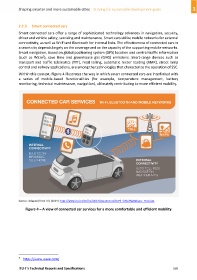Page 605 - Shaping smarter and more sustainable cities - Striving for sustainable development goals
P. 605
2.2.3 Smart connected cars
Smart connected cars offer a range of sophisticated technology advances in navigation, security,
driver and vehicle safety, servicing and maintenance. Smart cars utilize mobile networks for external
connectivity, as well as Wi‐Fi and Bluetooth for internal links. The effectiveness of connected cars in
a smart city depends largely on the coverage and on the capacity of the supporting mobile networks.
Smart navigation, based on global positioning system (GPS) location and central traffic information
2
(such as Waze ), save time and greenhouse gas (GHG) emissions. Short‐range devices such as
transport and traffic telematics (TTT), road tolling, automatic meter reading (AMR), street lamp
control and railway applications, are among the technologies that characterize the operation of SSC.
Within this context, Figure 4 illustrates the way in which smart connected cars are interlinked with
a series of mobile‐based functionalities (for example, temperature management, battery
monitoring, technical maintenance, navigation), ultimately contributing to more efficient mobility.
Source: Adapted from ITU (2014): http://www.itu.int/en/fnc/2014/Documents/S5P3_St%c3%a9phane_Petti.ppt
Figure 4 – A view of connected car services for a more comfortable and efficient mobility
____________________
2 https://www.waze.com/
ITU‐T's Technical Reports and Specifications 595

